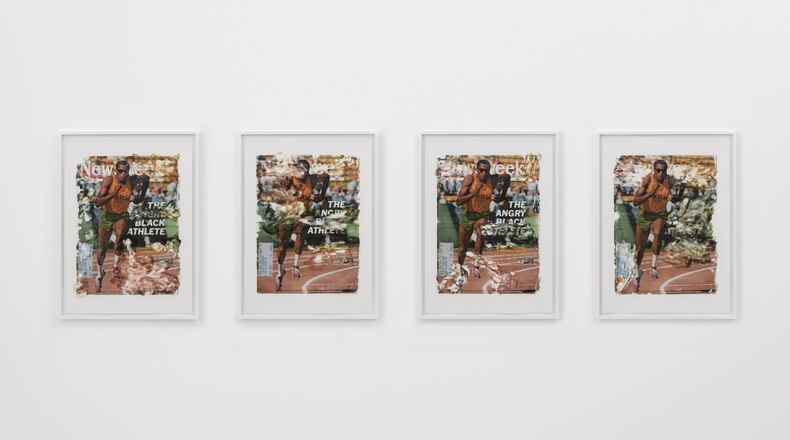An art exhibition centered on a gesture, "With Drawn Arms: Glenn Kaino and Tommie Smith" at the High Museum of Art focuses on a formative moment of American political protest.
At the 1968 Summer Olympic Games in Mexico City, black American sprinter Tommie Smith and teammate John Carlos created a sensation when they mounted the podium to accept their gold and bronze medals and offered fists raised in protest over human rights abuses against black people in America and around the world.
The gesture had immediate ramifications: Smith and Carlos were forced out of the Olympic Village and received death threats when they returned home. Smith was called “the angry black athlete” on the cover of Newsweek (a moment commemorated in several artworks on display), and the pair were disparaged as “disaffected black athletes.” International Olympic Committee President Avery Brundage called the gesture “the nasty demonstration against the American flag by Negroes” and strove to wipe the incident from Olympics history even though in many circles; among their fellow African-Americans and college students, Smith and Carlos were lauded as heroes.
>> RELATED: John Carlos, Olympian who raised fist in 1968, on "take a knee"
Centering on this defining moment of political protest in American history, at its heart “With Drawn Arms” is about America’s troubled relationship to racial injustice and the strange irony that black Americans are often the most suppressed when it comes to speaking about the circumstances that most affect them.
Today former Californian Smith lives in Stone Mountain and has been a collaborator since 2013 with Los Angeles-based artist Glenn Kaino, creating an array of artworks organized around the meaning and merit of protest. Kaino has founded this deep dive into Smith’s formative protest on a blend of grand, conceptual artworks, but more often far more modest objects, like a T-shirt featuring Smith’s silhouette and that iconic gesture; an excerpt from a documentary work in progress on Smith; or a rainbow of screen prints with a repeated refrain of “Unite” displayed like inspirational messages on a high school classroom wall. An assortment of drawings made during workshops with high school and college students engage the next generation of Americans in the ideas of social protest raised by Smith’s seminal gesture. “Invisible Man: Tommie Smith,” a sculpture placed on the edge of the piazza, articulates a central theme of the exhibition, of the invisibility of one’s humanity when controversy enters the fray.
>> RELATED: Tommie Smith: An American icon
Flash-forward to 2018 and “With Drawn Arms” is a reminder that the outrage over political protest continues as in NFL quarterback Colin Kaepernick’s protest of police violence against black Americans by taking a knee during the national anthem. And yet, like Kaepernick’s bent knee gesture, Smith’s and Carlos’ raised fist also came with a bowed head: Both gestures assume a degree of humility and sublimation, a powerful sense that even within that politicized gesture, these Americans have created a language of peaceful protest.
>> RELATED: This Life: If Nike can stand with Kaepernick, I can shell out extra for sneakers
Defiantly political in the midst of these very divisive times, “With Drawn Arms” is in some ways a brave show for the High, certain to alienate a segment of its audience. But while the emotions and anger at play in this exhibition are tangible and merited, aesthetically and conceptually the show can be less impactful. The exhibition itself is an uneven blend of artifacts from Smith’s Olympic and student athlete days, including photographs, medals, an ROTC uniform hat, a thank-you note to Smith from the wife of W.E.B. DuBois, racing batons and more conceptual art objects. One of those conceptual pieces is “Bridge,” a monumental 100-foot-long work of 150 abstracted gold arms cast from Smith’s arm, suspended from wire into an undulating sculptural form like a spinal column. The work dominates the second-floor gallery of the Anne Cox Chambers wing and has a powerful, resonant presence, at once memorial and call to arms.
ART REVIEW
“With Drawn Arms: Glenn Kaino and Tommie Smith”
Through Feb. 3. 10 a.m.-5 p.m. Tuesdays-Thursdays and Saturdays; 10 a.m.-9 p.m. Fridays; noon-5 p.m. Sundays. $14.50, ages 6 and above; free for children 5 and younger and members. High Museum of Art, 1280 Peachtree St. NE, Atlanta. 404-733-4444, high.org.
Bottom line: Political protest is not easy and it isn't without consequences as this exhibition — an interesting blend of teaching tool and conceptual art project — centered on social justice, race and American history demonstrates.
IN RELATED NEWS:
About the Author
Keep Reading
The Latest
Featured





